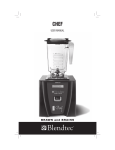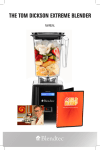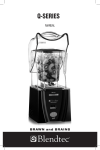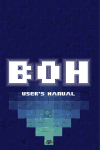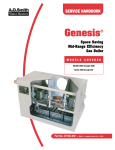Download Blendtec Q-SERIES Operating instructions
Transcript
ABC SMOOTHER SPACESAVER
MANUAL
2
Table Of Contents
Section Page
Section 1.....Important Safeguards 5
Section 2.....Component Overview 7
Section 3.....Unpacking 8
Section 4.....Installation 9
Section 5.....Operating Instructions 11
Section 6.....Warranty and Service 15
Appendix A.....ABC Operation 17
Appendix B.....Product Diagrams
19
3
4
SECTION 1 – IMPORTANT SAFEGUARDS
READ ALL INSTRUCTIONS CAREFULLY BEFORE USING YOUR
BLENDTEC MACHINE.
1.1 SAFETY CERTIFICATION
The ABC, Smoother, and SpaceSaver
blenders and accessories are certified by ETL
to UL standard 763, and to CSA standard C22.2 No. 195-m1987, and to CE
Standards.
1.2 HEALTH CERTIFICATION
The ABC, Smoother, and SpaceSaver
blenders and accessories are certified by
NSF International.
R
1.3 AVOID CONTACT WITH MOVING PARTS
• Keep fingers, hands, hair, and clothing away from all moving parts.
• Keep all utensils away from the drive socket and blender blades during
operation. Metal utensils will damage blades.
• NEVER put hands into blender jar or add substances by hand when blender
is operating.
• NEVER place jar into drive socket if blender motor is operating. Do not rock
the blender when it is operating. Keep the blender jar straight up until the
operation is complete.
• These precautions will prevent personal injury and/or damage to the blender.
1.4 POWER CORD PRECAUTIONS
• Do not operate with a damaged cord or plug.
• If the supply cord is damaged, it must be replaced by the manufacturer or its
service agent in order to avoid a hazard.
• Do not let the cord hang over the edge of the work surface.
• Never use an extension cord with the unit.
• Unplug the blender motor before removing from sound enclosure, changing
blender locations, or cleaning.
1.5 NEVER ATTEMPT TO REPAIR THE POWER UNIT
Never remove the blender’s motor housing. The blender motor does not contain
self-adjustable or serviceable parts. All service and adjustments must be made
by a qualified service agent. Removing the cover or attempting to service
the blender will void the warranty.
1.6 TURN THE UNIT OFF WHEN NOT IN USE
Do not use any other electrical equipment on the same circuit as the blender
or you risk overloading the circuit and either damaging the blender electronics
or blowing the circuit protection.
1.7 NEVER OPERATE IF THE UNIT APPEARS DAMAGED
5
If the blender malfunctions call Blendtec customer service (international
customers contact a Blendtec qualified service agent). If it is dropped or
damaged in any way, return the blender to Blendtec customer service
(international customers contact a Blendtec qualified service agent)
immediately for examination, repair, electrical or mechanical adjustment, or
possible replacement.
1.8 NEVER OPERATE IN LIQUID
Do not operate the blender motor in water or any other liquid. Avoid any
contact between the motor and water. Deliberate use of machine outdoors in
conditions where precipitation is present will void the warranty.
1.9 NEVER PUT ITEMS SUCH AS METAL, ROCKS, OR OTHER
HARD MATERIALS INTO BLENDER JAR
Metal utensils and other hard materials are dangerous. They can cause injury or
damage. Damage caused by such foreign objects will void the warranty.
1.10 NEVER OPERATE USING ATTACHMENTS NOT SOLD BY
BLENDTEC
The use of unauthorized attachments voids the warranty and may cause fire,
electric shock, or injury.
1.11 ALWAYS SECURE THE BLENDER LID BEFORE STARTING THE
MACHINE
If you have a sound enclosure, you must still place a lid on the blender jar
before you close the cover.
1.12 AVOID TOUCHING THE METAL BASE AFTER EXTENSIVE USE
The metal base of the blender may become hot after numerous cycles.
1.13 BLADES ARE SHARP! HANDLE CAREFULLY
1.14 NEVER CLEAN THIS UNIT WITH A WATER JET.
1.15 THE POWER CORD RECEPTACLE WHICH POWERS THE
BLENDER MUST ALWAYS BE ACCESSIBLE.
SAVE THESE INSTRUCTIONS
6
SECTION 2: COMPONENT OVERVIEW
BLENDER MOTOR BASE
The blender motor is located within the blender motor base and contains the
components which run the blender including the electric motor, drive shaft, and
microprocessor controlled circuit board. The blender motor base consists of
the motor housing, touchpad, Liquid Crystal Display (LCD) screen, drive socket,
and the power switch (See Appendix B, figures 1.1 and 1.2).
• Motor housing: Encloses the power unit in a general stainless steel casing.
Never remove the motor cover. Removal of the motor cover will void the
warranty.
• Touchpad: Consists of six buttons which contain pre-programmed settings as
well as a pulse for selective blender control.
• LCD Screen: When a cycle is completed, the display increments the
cumulative cycle for warranty purposes. It also indicates overload or overtemperature conditions.
• Drive Socket: This is where the shaft on the jar blade assembly couples with
the motor drive socket so it can turn the blade. This is a direct drive coupling.
•
Power Switch: This is the On/Off switch which controls power to the blender
motor base.
2.2 BLENDER JAR ASSEMBLY
The blender jar assembly consists of the blender jar, blade assembly, and lid.
The blender jar assembly integrates these components to ensure consistently
blended drinks and greater operator safety.
Jar: Made from a safe, durable material to provide maximum performance as
well as clear visibility of blender performance.
Blade Assembly: Stainless steel, designed to ensure fast, consistent blending.
Lid: Designed to provide ease of handling and quick removal for high-speed
operations.
2.3 OPTIONAL SOUND ENCLOSURE
The sound enclosure reduces noise created during blender operation.
2.4 OPTIONAL MOTOR STAND
A “top-of-the-counter” version of the blender is created by combining the
sound enclosure described above with a motor stand into which the blender
motor base is inserted. This allows for portable operation of the blender. In the
Q-series model, the motor stand significantly reduces motor noise.
7
2.5 POWER SPECIFICATIONS
Blendtec Blenders are made with power specifications listed below
according to your specific model.
110/120 VOLT BLENDTEC BLENDERS ARE REQUIRED
TO BE PROTECTED BY A DEDICATED 20 AMP
CIRCUIT BREAKER OR FUSE.
MODEL (110/120 VOLT)
AMPS
WATTS
ICB7 (Smoother20)
20
2400
ICB4 (Smoother15, SpaceSaver15)
15
1800
ICB3 (Smoother13, SpaceSaver13)
13
1560
ABC7 (ABC20)
20
2400
ABC4 (ABC15)
15
1800
ABC3 (ABC13)
13
1560
220/240 VOLT BLENDTEC BLENDERS ARE REQUIRED
TO BE PROTECTED BY A DEDICATED 13 AMP
CIRCUIT BREAKER OR FUSE.
MODEL (220/240 VOLT)
AMPS
WATTS
ICB5
9
2000
ICB3
6.5
1560
ABC5
9
2000
ABC3
6.5
1560
SECTION 3: UNPACKING
SAVE THE TWO FOAM INSERTS AND ALL PACKAGING FOR FUTURE STORAGE
OR SHIPPING. SAVE THESE INSTRUCTIONS FOR FUTURE REFERENCE.
3.1 UNPACKING YOUR BLENDER
1. You should have received the following items:
· Model ICB or ABC blender motor Base
· Blender Jars (2 each) with Lids (2 each)
· Sound Enclosure and motor stand (standard with Q-series)
· Additional Blender Jars (optional)
8
2. Remove blender motor base, sound enclosure components, blender jars, and
lids from carton.
3. Unwind the power cord.
4. Check for and remove any packing material which may have blocked
ventilation holes in either the power unit or the black motor stand.
5. Inspect all items to ensure no damage occurred in shipment.
6. If any damage has occurred contact your Blendtec service agent
immediately.
3.2 RECORDING YOUR SERIAL NUMBER AND DATE OF SHIPMENT
Record your blender base serial number and date of purchase in the space
below. You will need these when contacting Blendtec for service.
Blender Serial No. ____________________________________
Date of Purchase ___________________________________
Refer to these whenever contacting your Blendtec service agent.
SECTION 4: INSTALLATION
4.1 Above Counter Installation
(For SpaceSaver model, disregard mention of sound enclosure and motor
stand.)
1. Ensure that an electrical receptacle is readily accessible when you locate
the equipment.
2. Be sure the unit is switched off and unplugged. Remove the lid by lifting the
top straight off the bottom. Lay the sound enclosure top aside.
3. Route the power cord from the top through the bottom of the clear sound
enclosure bottom. Remove the bottom cover on the motor stand. Insert the
motor base carefully into the opening in the bottom of the motor stand. Be
sure the rubber gasket fits smoothly and tightly into the motor stand.
9
4. Slide the power cord and the motor base into the black plastic motor stand
with the touchpad facing the front, fitting the motor base and clear sound
enclosure bottom snugly into the motor stand. Extend the cord out the bottom
of the base to its full length. Snap motor stand bottom cover in place.
5. Set the equipment on the counter and re-install the clear sound enclosure
top.
6. Ensure clearance above the counter around the installation to allow for
unhampered operation of the sound enclosure.
4.2 Preparation for In-Counter Installations
1. Identify desired blender location. Consider preferences such as proximity
to ingredients, how close you want to be to customers, and available counter
space.
2. Ensure potential site meets all dimensional requirements. (See Appendix B,
Figure 3.1, 3.2, and Figure 4.)
• Countertop can be no thicker than 3/4 in (19 mm). A countertop thicker than
3/4 in. (19 mm) will obstruct ventilation louvers on the upper sides of the
motor.
• If installing more than one blender, allow 14 to 16 in. (356 - 406 mm) centerto-center blender spacing.
• If installing a sound enclosure, allow a clearance of at least 8-1/2 in. (216 mm)
from the sound enclosure to the wall and 26 in. (660 mm) from the counter
top to any over-the-counter cabinetry.
• Ensure lower cabinetry allows adequate airflow. There should be at least
8-1/8 in. (205 mm) from the counter top to the next lower shelf of the cabinet,
leaving a minimum space of 3 in. (76 mm) between the bottom of the motor
base and the lower shelf. Cabinetry should not be closed, but should allow
free flow of air from outside to inside cabinet space.
NOTE: The blender motor base draws ambient air into the louvers located on
the bottom of the motor. It then evacuates hot air through the louvers located
on the upper sides of the motor. Ensure a sufficient amount of air circulates
beneath the motor base to allow cooling. Hot air should not be trapped
beneath the counter top. Plastic bags, cups, etc. should not be stored closer
than 3 inches (76mm) from the bottom of the motor base.
3. Cut a hole in the counter top 4-3/8 in. (111 mm) wide and 5-7/8 in. (149 mm)
long with the shorter side facing the operator (See Appendix B, Figure 4.).
Make sure all space requirements and measurements are correct
BEFORE cutting.
4.3 In-Counter Installation
(For SpaceSaver model, disregard mention of sound enclosure)
1. Ensure that an electrical receptacle is readily accessible when you locate
10
the equipment.
2. Remove the clear sound enclosure lid (top) by lifting the top portion of the
sound enclosure off. Place the clear sound enclosure bottom on the counter
making sure the hole in the bottom of the sound enclosure is aligned with the
hole in the counter top.
3. Thread the power cord through the base of the sound enclosure and the
counter top hole being careful not to scratch or damage the enclosure.
4. Gently place the motor into the sound enclosure and slide it into the hole
in the countertop. Make sure the LCD indicator and touchpad are facing the
operator’s side of the counter. Also ensure that the rubber gasket on the motor
fits snugly and evenly into the sound enclosure and countertop holes.
5. Carefully re-install the sound enclosure lid. Never drop or slam enclosure lid.
6. Plug the unit into a receptacle with appropriate protection. Make sure power
switch is turned off before plugging unit in.
SECTION 5: OPERATING INSTRUCTIONS
5.1 OPERATIONAL OVERVIEW
1. Raise the sound enclosure lid. If blender is not turned on, turn on the main
power switch located on the front of the blender motor.
2. Place the properly filled blender jar on the motor base, making sure the jar
is seated all the way down into the motor drive socket and jar lid is secured
tightly on the jar.
3. Press the button on the touchpad of your desired blender cycle.
5.2 AUTOMATIC CYCLE OPERATION
If not otherwise specified, Blendtec blenders are programmed to the default
Multipurpose (MULTI) blender program. See the Blendtec Cycle
Chart included with this manual for details regarding programming and
operation of your blender. This chart can also be found online at blendtec.com.
5.3 MANUAL OPERATION
Pulse Button: Blends mixture at a constant HIGH speed (70 percent power)
while button is depressed. Generally this is the last button on the far right of
the blender touchpad and is indicated by the letter “P”. This button is normally
used for additional blending once a programmed cycle has already been used.
11
5.4 TROUBLESHOOTING SUGGESTIONS
BLENDER MOTOR WILL NOT TURN ON: If the blender motor will not turn on,
try the following:
• Make sure the main power switch on the lower-front panel is turned on.
• Check the house current breaker switch or fuse to make sure it is set to
• the on position.
• Unplug, then re-plug in the power cord.
• Determine if the numbers on the Liquid Crystal Display (LCD) indicator
are lighted. An absence of lighted LCD indicates a lack of power to the
microprocessor.
• Check the LCD
A reading of “OVERTEMP” indicates an overheated condition has been
detected and the motor has been disabled until the unit cools to operating
temperatures. Unplug blender and allow motor to cool for at least 20 minutes.
A reading of “OVERLOAD” indicates an overload on the motor. (Check the
blender jar for blockage.) Turn the blender off for 10 seconds (using the switch)
then turn the blender on again to clear the overload condition.
A reading of “LOW VOLTAGE” indicates not enough voltage coming to the
motor. Turn the blender off. Correct the cause of low voltage. (Normally
caused by more than one appliance drawing power on the same circuit, or by
low power from a power source {brown out}.) Turn the blender on again and
continue operations.
BLADE STOPS: If the “OVERLOAD” condition stops the blender, remove the
blender jar and carefully check for blockage of the blade. If no blockage is
found, replace jar and use the Pulse button on the touchpad to quickly pulse
the blade through the mixture. Once the blade spins freely, a programmed
button may be used.
NOISE LEVEL CHANGES: If the blender noise level has increased significantly
from original levels, determine whether the sound is coming from the motor
base or the jar.
• Motor: Check to see if the excess noise is coming from the motor base.
Remove the jar from the motor base and press cycle number one. Listen
to the motor sound without a jar attached. If it is excessively noisy, contact
Blendtec (international customers contact a Blendtec qualified service agent).
• Jar: Check to see if the excess noise is coming from the jar. Place the jar
back on the base. Run the motor for a few seconds using the Pulse button.
Switch jars back and forth to determine whether the sound changes as
different jars are used. If a jar is excessively noisy, or if the blade assembly
seems loose or sounds “gravelly” when turned by hand, contact Blendtec
12
contact Blendtec (international customers contact a Blendtec qualified
service agent) for assistance.
UNSATISFACTORY BLENDED TEXTURE: If the blended texture of
product is lumpy or uneven, do the following:
• Make sure the mixture is not cavitating during the cycle. Cavitation is a
condition in which the blender blade spins freely in an air pocket within the
drink mixture because the mix is too cold or too solid. This problem can be
corrected by increasing the mix temperature (by reducing ice, increasing
liquid and/or insuring that the frozen ingredients used in the recipe are never
colder than 10 degrees Fahrenheit or -12 degrees Celsius). When the right
combination of correctly tempered ingredients is used, the resulting drink is
always smooth, thick, and blendable without operator attention.
• Increase cycle time. If the drink is mixing well but has not had enough time
for complete blending, try a longer cycle (usually by using a higher button
number to start the blender) or touch and hold the Pulse button for required
extra blending time.
• Make sure the drive shaft on the jar is fully engaged into the drive socket or
that the blade is firmly affixed to the drive shaft.
TRIED EVERYTHING? If none of the preceding suggestions work, contact
Blendtec contact Blendtec (international customers contact a Blendtec
qualified service agent).
5.5 CLEAN BLENDER JAR DAILY
1. Using hot tap water, add 4 cups (1liter) of water and 1 to 2 drops (7 ml) of
liquid dish washing soap to the blender jar.
2. Place the lid tightly onto the jar. Place the blender jar on the motor base and
press the pulse button for 15 seconds.
3. Rinse with clear water until all soap is rinsed from jar and lid.
4. If jar is stored upside down, shake excess water from jar after cleaning.
5. Jars can be stacked to save space if needed.
NOTE: When washing the blender jar in a dishwasher, the jar should be placed
on the top rack. Blender jars are dishwasher safe up to 220 degrees Fahrenheit
(104 degrees Celsius).
13
5.6 LONG-TERM SANITATION OF JAR
1. Sanitize jar per local code by filling the blender jar with a sanitizer diluted to
manufacture’s specifications. Bleach, properly diluted, can be used.
2. Add 1 teaspoon (5 ml) of liquid chlorine bleach.
3. Stir for 10 seconds to mix water and bleach. Let mixture stand in blender jar
for 5 minutes.
4. Empty water/bleach mixture. Store jar as described in Sections 5.4 and 5.5
5.7 CLEANING OF MOTOR BASE
1. Make sure the main power switch is off and blender is unplugged before
cleaning.
2. When necessary, clean the metal top and sides of the blender motor base
with a damp rag. Mild cleaners such as Windex® may be used.
3. Remove the rubber gasket that sits on top of the motor stand, under the top
of the motor base, and clean as needed.
4. If needed, the drive socket can be cleaned using a cotton swab or toothpick.
5.8 CLEANING TIPS AND CAUTIONS
Do not use abrasives to clean the blender motor base, jar, or sound enclosure
as this will dull or scratch the surface.
• Do not use a water jet of any kind to clean this equipment.
• NEVER submerge the blender motor base in water – THIS WILL VOID
WARRANTY
• Avoid submerging the blender jars for more than 5 minutes. Water penetration
through the lower jar seals will reduce the jar life. If jar is stored upside down,
shake excess water from the jar after cleaning.
• For long-term storage of jar, apply a small amount of food-grade oil (such as
vegetable oil) to the seals around the blade assembly, both inside and outside
of the blender jar.
14
SECTION 6: WARRANTY AND SERVICE
PROCEDURE
6.1 WARRANTY DESCRIPTION
MOTOR:
Standard Blendtec United States (US) warranties are as follows:
ABC20, ABC15, ABC13, Smoother20
3 years or 20,000 cycles
Smoother15, Smoother13
2 years or 15,000 cycles
SpaceSaver15, SpaceSaver13
1 year or 10,000 cycles
Standard Blendtec International (outside US) warranties are as follows:
ABC
2 year parts, 1 year labor
Smoother
2 year parts, 1 year labor
SpaceSaver
1 year parts, 1 year labor
JAR:
The jar and internal bearing assembly are warrantied
against failure for one year.
BLADES:
The stainless steel blade is warrantied against breakage for the life of the jar.
Please note that dulling of the blade may occur as a result of usage and does
not affect blending effectiveness.
SOUND ENCLOSURE:
The sound enclosure is warrantied for 90 days against manufacturing defects.
DRIVE SOCKET:
The drive socket (see Appendix B, Fig. 1.2) is warrantied for the life of the
machine.
Warranties begin from date of shipment, or on date of purchase where
proof of purchase is provided. Cosmetic damage and abuse are not included
within this warranty.
6.2 SERVICE PROCEDURE
Should you experience any difficulty in using your Blendtec blender, please do
15
the following:
UNDER WARRANTY
1. Contact Blendtec (internationally contact a Blendtec qualified service agent)
immediately to diagnose the difficulty. Please have your serial number ready
as well as a description of the problem. Do not attempt to do your own repairs.
Repairs made by persons other than Blendtec authorized service representatives
will void the warranty. Many issues can be resolved simply and quickly over the
phone.
2. If the difficulty cannot be resolved over the phone, your unit may require
replacement. If you are under warranty, Blendtec will repair or replace your unit at
no cost. Cosmetic damage and abuse are not included.
OUT OF WARRANTY
1. Contact Blendtec (internationally contact a Blendtec qualified service agent)
to diagnose the difficulty. Please have your serial number ready along with a
description of the problem. Many issues can be resolved simply and quickly over
the phone. DO NOT attempt to do your own repairs or it will VOID your warranty.
2. If you wish to have your unit repaired, contact Blendtec (internationally contact
a Blendtec qualified service agent) for instructions. Blendtec (internationally a
Blendtec qualified service agent) will bill you for services rendered.
When shipping your blender unit to the service agent (either in warranty or out of
warranty), please include the following:
Name:
Company:
Store Number:
Address:
Phone:
Serial Number:
(Found on the underside of the motor)
Cycle Count:
(Number on the LCD Screen)
Purchase Date:
16
Place of Purchase:
Problem Description:
APPENDIX A: ABC BLENDER OPERATION
A1: Operation
The ABC models features an interlock safety switch that prevents the unit from
operating unless the sound enclosure is completely shut. To operate the ABC,
press the desired button. A red LED will light up above the button selected and
will remain lit until another button is selected or the button is touched a second
time during operation. The machine will start the blending cycle once the sound
enclosure lid has been closed. Touching any button during the motor operation
will stop the blender and de-select the button. Touching the “P” (Pulse) button
when the sound enclosure lid is open will deselect all programs. The sound
enclosure lid can then be closed without starting a cycle.
A2: Interlock Modes
Automatic Interlock Mode: Equipment is shipped with this selection installed.
In this mode the motor will not operate unless the sound enclosure lid is
closed. The selected program (as indicated by the lighted program button on
the touchpad) will start automatically each time the sound enclosure is closed
unless the lighted button is pushed again to de-select the program. To restore
this interlock mode from either Safety or Manual mode, press the “P – 1 – 3”
buttons in quick succession.
Safety Mode: In this mode, the motor will not operate unless the
sound enclosure is closed. The motor will not automatically start when the
enclosure is closed. A button must be pushed each time the operator wishes
to start a drink cycle. To select this mode from Automatic Interlock or Manual
mode, press “5 – 1 – 3” in quick succession.
Manual Mode: In this mode, the safety interlock is disabled and the blender
motor will start any time a button is pressed. To select this mode from
Automatic Interlock or Safety mode, press the “4 – 1 – 3” buttons in quick
succession.
17
18
APPENDIX B - PRODUCT DIAGRAMS
FIGURE 1.1 - FRONT VIEW: BLENDER MOTOR AND JAR
Lid
Jar
Blade
Assembly
LCD Screen
Power Switch
FIGURE 1.2 - TOP VIEW: MOTOR
Drive Socket
Touchpad
Motor Housing
LCD Screen
Power Switch
19
20
9.35”
(237.49 mm)
SIDE VIEW
(OPEN ENCLOSURE)
9.35”
(237.49 mm)
SIDE VIEW
FRONT VIEW
18.41”
(467.62 mm)
9.29”
(235.96 mm)
18,41”
(467.62 mm)
22.51”
(571.75 mm)
FIGURE 2.1 - ABOVE COUNTERTOP: ABC, SMOOTHER
(WITH Q SERIES COMPONENTS)
(65.78 mm)
2.59”
FRONT VIEW
6.32”
(160.53 mm)
16.09”
(408.69 mm)
SIDE VIEW
8.22”
(408.69 mm)
16.09”
(408.69 mm)
FIGURE 2.2 - ABOVE COUNTERTOP: SPACESAVER
21
22
8.97”
(227.8 mm)
SIDE VIEW
8.49”
(215.6 mm)
FRONT VIEW
10.24”
(260 mm)
10.24”
(260 mm)
3.03”
(77 mm)
SIDE VIEW
(OPEN ENCLOSURE)
8.00”
(203.2 mm)
14.37”
(365 mm)
FIGURE 3.1 - IN - COUNTER: ABC, SMOOTHER
(WITH Q SERIES COMPONENTS)
FIGURE 4 - Countertop Hole Template
5-7/8”
(149.22 mm)
4-3/8”
(111.125 mm)
23
1206 South 1680 West
Orem, UT 84058
801-222-0888
www. blendtec.com
OWN-CE-010 Manual for ABC, Smoother, and SpaceSaver v8 Aug 10




























